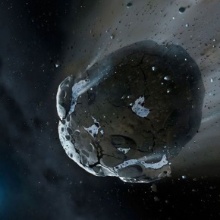Named “3200 Phaethon” after the brother of the sun god Helios, this five-kilometer wide asteroid orbits the sun in relatively close proximity. This asteroid is the intended target of Destiny+, a Japanese-German mission to demonstrate the use of innovative technologies in interplanetary space. The most important scientific instrument to be used on the mission, the dust telescope Destiny Dust Analyzer (DDA), is being developed at the University of Stuttgart.
As part of the Destiny+ (Demonstration and Experiment of Space Technology for Interplanetary Voyage) project, the mission will involve flying a short distance above 3200 Phaethon and examining it using high resolution cameras. During this phase, the DDA dust telescope will analyze the composition of the micro particles from inside the active asteroid. However, the first step is to characterize cosmic dust during a four-year planetary journey undertaken at a distance of approximately 150 million kilometers from the sun. This makes the DDA the mission’s most important scientific instruments.
Phaethon is one of just a few known active asteroids and its orbit is ‘only’ 21 million kilometers away from the sun at its closest point. A few years ago, scientists were able to prove that the asteroid emits dust particles when it is near to the sun, similar to a comet.
The measurements taken with the DDA make it possible, based on the mass-spectrometric investigations, to learn more about the structure and composition of asteroids and interplanetary and interstellar dust particles. Furthermore, scientists hope to discover more about the development and evolution of our solar system. Thus, the dust astronomy with Destiny+ functions as a bridge between astrophysics and planetary science.
The development of the DDA dust telescope is being overseen by Dr. Ralf Srama at the University of Stuttgart’s Institute of Space Systems, supported by DLR Space Administration, with funds from the Federal Ministry of Economics. Over the last few decades, Germany has gained significant knowledge in this field, particularly with the project Cosmic Dust Analyzer (CDA) used on the Cassini Mission. The dust telescope is the University of Stuttgart’s next important project in the fields of space sensor technology and dust astronomy.
| Contact | Dr. Ralf Srama, University of Stuttgart, Institute of Space Systems, Tel. +49 711 6856 2511, srama@irs.uni-stuttgart.de |
|---|


